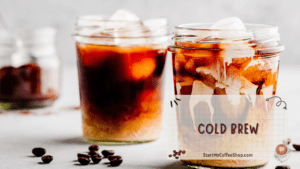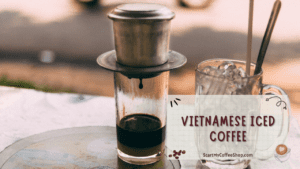Iced coffee has become a popular beverage, providing a refreshing respite from the heat. It’s vital to look into popular options that use unique brewing or mixing procedures, resulting in a particular flavor profile to properly enjoy the best-iced coffee.
The best way to prepare a refreshing iced coffee is for you to choose from popular options like cold brew, iced latte, frappuccino, or Vietnamese iced coffee, each with its unique brewing or blending techniques.
In this article, we’ll dig into the world of iced coffee, learning how to make a wonderfully refreshing and delicious cup. Let’s go on an adventure to discover the finest method to drink this delectable beverage.
Cold Brew: The Art of Slow Extraction

With its smooth and rich flavors, cold brew coffee has become a popular option among coffee connoisseurs. Compared to conventional hot brewing techniques, this way of making coffee requires much more patience and accuracy to provide the best results. The steeping procedure, in which coarsely ground coffee beans are submerged in cold water for an extended period, usually lasting from 12 to 24 hours, is the secret to creating a delectable cold brew. A less acidic and more mellow brew is produced as a result of this lengthy extraction and can be savored over ice or combined with other ingredients to create a unique iced coffee experience.
You will require a few necessary tools and supplies before starting your cold brew quest. To ground your coffee beans to a coarse consistency, first get a high-quality coffee grinder. The resulting brew is less likely to be over-extracted and bitter because of the coarser grind size. You will also need a container for steeping, such as a sizable glass jar or a special cold brew maker. The quality and flavor of your cold brew will be directly impacted by the cleanliness and food safety of the container.
Making a cold brew is not very difficult to prepare. Measure out the necessary quantity of coarsely ground coffee to start. As a general rule of thumb, a ratio of 1:4 coffee to water by weight is frequently employed, but you can change this to suit your tastes. In the container you’ve chosen, combine the coffee grounds with cold water, making sure to completely cover all of the grounds. To ensure an equal extraction, gently stir the mixture using a spoon or spatula.
When the coffee and water have been thoroughly mixed, cover the container and put it in the refrigerator or another cool, dark location for the specified amount of time. A smooth, low-acid brew is produced as a result of the prolonged steeping time, which enables the water to gradually extract the coffee’s flavors. It’s vital to watch the process and determine the ideal steeping time for the flavor profile you want because steeping for too long can result in an extremely strong or bitter taste.
It’s time to separate the coffee grinds from the liquid when the steeping time has passed. Set a layer of cheesecloth over a fine-mesh sieve or a coffee filter and place it over a different clean container or a pitcher. As you pour the cold brew mixture through the sieve, let the liquid run through while the grounds are caught. Due to the fine uniformity needed for a smooth outcome, filtering might be time-consuming during this procedure.
The cold brew can be transferred to a storage container and kept in the refrigerator once it has been filtered. You can normally enjoy cold brew coffee that is ready to drink whenever you want by storing it in the refrigerator for up to two weeks. Depending on your liking for taste, dilute the cold brew concentrate before serving it with water, milk, or your favorite dairy substitute. To further cool the beverage and increase its pleasant properties, you can also add ice cubes.
Take into account experimenting with different additives and flavorings to improve your cold brew experience. You can add a splash of simple syrup, flavoring syrups, or even a tiny bit of vanilla extract for added sweetness. Include a dash of milk, cream, or condensed milk for a creamier texture. Don’t be afraid to use your imagination to add spices to your cold brew, such as cocoa powder or nutmeg for an additional decadent pleasure.
Read more about: How To Start A Coffee Stand: Key Elements To Consider
Iced Latte: The Perfect Marriage of Espresso and Milk
For coffee lovers who want a well-balanced cooled beverage with a powerful espresso and creamy milk, the iced latte is a go-to alternative. This traditional coffee brew, renowned for its smooth and energizing attributes, provides a lovely and fulfilling experience. The fundamental components that go into making a superb iced latte will be covered in this section, from the art of espresso extraction to the choice of milk and methods for striking the ideal balance between the coffee and milk components.
The espresso, the concentrated and vivid essence of coffee, is at the center of each iced latte. Using an espresso machine and a particular brewing technique, the espresso is extracted. High pressure is used in this machine to push hot water through the finely ground coffee, producing a tiny but intensely concentrated shot of espresso. The flavor profile of the iced latte is based on the espresso extraction, thus it is essential to ensure that it is done correctly. To get the flavor and intensity you want, you should carefully evaluate and change variables like grind size, water temperature, and extraction time.
A balanced and creamy iced latte is greatly influenced by the milk choice. Whole milk has historically been preferred because of its richness and capacity to balance the aggressiveness of espresso. However, because everyone’s tastes and dietary needs are different, substitutes can be used instead of milk, such as skim milk, almond milk, soy milk, or oat milk. Each type of milk contributes special qualities that have an impact on the iced latte’s flavor and texture as a whole. People might learn their favorite milk combination by experimenting with several milk possibilities.
The technique of creating the ideal blend of coffee and milk increases the iced latte experience. The milk adds a smooth and creamy texture while the espresso supplies the intensity and flavor basis. Finding the right balance between these two factors is a matter of taste and can be tailored to fit particular preferences. A basic rule of thumb is to use milk to espresso ratio of 1:3 or 1:4, however, variations can be made to suit individual tastes. Finding the ideal mix that produces an amazing iced latte customized to your palate requires experimentation.
Flavored syrups provide a unique way to individualize and customize the iced latte. Flavored syrups can improve and enrich the whole taste experience, from traditional alternatives like vanilla, caramel, or hazelnut to more daring selections like lavender or cinnamon. The iced latte can have different amounts of these syrups added to it, giving customers the freedom to experiment and find the sweetness and richness of flavor that they desire. Flavored syrups can give your iced latte a wonderful twist, whether you want a delicate trace of flavor or a more strong taste profile.
Pour the necessary amount of espresso into a glass or cup that has ice before assembling the ideal iced latte. The chosen milk should then be gradually added, blending with the espresso as it pours over the ice. To ensure that the coffee and milk are properly incorporated, gently stir. The iced latte can be topped with whipped cream, cocoa powder, caramel sauce, or any combination of these for visual appeal and flavor. These finishing touches not only improve the aesthetic appeal but also add to the overall flavor.
Frappuccino: Blending Creativity and Chill
When coffee lovers are looking for a frosty delight, Frappuccinos captivate their taste buds as the epitome of a cool and sumptuous coffee treat. These well-liked blended drinks skillfully blend the depth of coffee, the coolness of ice, and a broad variety of mouthwatering flavorings. The possibilities for creating a revitalizing frappuccino are virtually limitless, ranging from traditional choices like caramel and mocha to cutting-edge combinations. In this section, we’ll get deep into the craft of making these delectable drinks, learning about the essential ingredients, blending methods, and inventive ways to personalize flavors. We’ll also get advice on how to get the ideal consistency and presentation.
The combination of coffee, ice, and flavorings is the basis of a frappuccino. Choose your desired coffee base first. However, instant coffee or cold brew concentrate can also be used. Brew coffee or espresso is typically used. The frappuccino’s foundational rich and robust flavor comes from the coffee. There are also decaffeinated versions available for people who want a mellower flavor.
Ice is a necessary component to produce a distinctive frosty texture. Along with the coffee, add a good amount of ice to the blender. In addition to cooling the beverage, the ice also contributes to its creamy and thick consistency. You can fine-tune the texture to your preferences by experimenting with the amount of ice, whether you want a more slushy or smooth outcome.
The interesting part is now here: flavorings. Frappuccinos provide a variety of options for personalizing and enhancing the taste experience. Chocolate, caramel, vanilla, hazelnut, and mocha syrups are common options. The frappuccino is transformed into a genuinely decadent delight when these syrups are added, adding rich and sweet flavors. Try out various combinations or even develop your distinct flavor profile by blending syrups to achieve the ideal harmony of richness and sweetness.
It’s time to blend after the ingredients have been combined. It is advised to use a powerful blender to get a smooth and creamy texture. To dissolve the ice and blend the ingredients, first pulse the blender a few times. The speed should then be gradually increased to produce a whirlpool effect that combines everything. Making sure that all the ice is completely integrated, blend the mixture until the required consistency is obtained. The frappuccino’s general frothiness and creamy mouthfeel are also a result of the mixing procedure.
If you want to improve your frappuccino experience, think about adding more toppings or improvements. Whipped cream is a preferred option since it gives the beverage a creamy and enticing appearance. Drizzle chocolate or caramel sauce over the whipped cream for an additional taste boost. Sprinkles of cocoa powder, cinnamon, or broken cookies can further improve the overall presentation by adding a pleasant tactile contrast.
A well-made frappuccino must have the ideal consistency. A drink should be the perfect amount of chilly without being too thin in texture. To get the appropriate thickness, adjust the ice amount and blending time accordingly. Keep in mind that everyone has different tastes, so feel free to experiment and modify the recipe to suit your preferences.
Another crucial component of the frappuccino experience is presentation. Use a clear glass or cup to serve your creation so that the layers and textures of the beverage can be seen. For ease of consumption, think of including a spoon or a straw. Add some more flair to the whipped cream by adding some cocoa powder, chocolate shavings, or caramel sauce as a garnish.
Vietnamese Iced Coffee: A Unique Fusion of Boldness and Sweetness

Vietnamese iced coffee, or Ca Phe Sua Da, is well renowned throughout the world for its excellent blending of robust coffee with sweetened condensed milk. This well-liked drink serves as a reminder of Vietnam’s rich culinary and cultural traditions. We will examine the traditional brewing process, the significance of choosing the right coffee beans, and the art of striking the ideal balance between coffee and sweetened condensed milk in this section as we delve into the essence of Vietnamese iced coffee.
A special device called a phin filter is used in the traditional Vietnamese iced coffee brewing process. This tiny metal filter, which is atop a cup of medium-coarsely ground coffee, is there. The coffee grinds are covered with hot water, which is then let to drip gradually into the cup. Coffee that has undergone this gentle extraction method is robustly flavored and powerful. The production of Vietnamese iced coffee is enhanced by the phin filter, which also lends a hint of cultural charm to the unique brewing experience.
For Vietnamese iced coffee to taste authentic, the type of coffee beans used is crucial. Robusta beans, which are renowned for their strong and full-bodied qualities, are frequently used to make Vietnamese coffee. In comparison to their Arabica counterparts, these beans offer a richer and bolder flavor, which pairs nicely with the sweetened condensed milk used in Vietnamese iced coffee. To ensure the best flavor and aroma in the final cup, it is crucial to choose high-quality coffee beans.
In Vietnamese iced coffee, finding the perfect harmony between the coffee and sweetened condensed milk is a delicate art. The creamy and decadent addition of sweetened condensed milk creates a pleasing counterpoint to the robust coffee aromas. Depending on individual taste preferences, the amount of sweetened condensed milk can be changed to provide a sweeter or milder flavor. The cold coffee and sweetened condensed milk combine when it is slowly poured over ice in a tumbler to create an enticing and pleasant beverage.
Vietnamese iced coffee continues to wow coffee connoisseurs all over the world with its distinct cultural charm and flavor profile. Its special appeal is a result of the traditional brewing process utilizing a phin filter, the use of premium coffee beans, and the careful balancing of the coffee with sweetened condensed milk. Discover the lovely cultural experience this captivating iced coffee variation offers to your palate by embracing the mysteries behind it.
Read more about: How to Start Your Own Coffee Brand: The Aroma of Entrepreneurship
Frequently Asked Questions

What distinguishes an iced latte from a cold brew?
To provide a smooth and less acidic flavor profile, coarsely ground coffee beans are steeped in cold water for a lengthy period using the slow extraction method known as cold brew. A balanced combination of strong coffee flavors and creamy richness can be found in an iced latte, which is produced by blending espresso with milk and serving it over ice.
Are frappuccinos flavors customizable?
Absolutely! You can completely personalize the flavors of frappuccinos so that they are to your taste. To give your frappuccino a unique flair, experiment with various syrups like caramel, mocha, or vanilla. To add even more decadence, you can garnish it with whipped cream, chocolate sauce, or cocoa powder.
How is traditional Vietnamese iced coffee made?
A small metal filter known as a phin is often used to make Vietnamese iced coffee, also known as Ca Phe Sua Da. Medium-coarse ground coffee is put into the cup, which the phin filter is placed on top of. The coffee is covered with hot water, which allows the coffee to flow gradually into the cup. The brewed coffee is then mixed with sweetened condensed milk and poured over ice to create a distinctive flavor profile. As a result, the coffee is robust, delicious, and slightly sweet.
To learn more on how to start your own coffee shop, check out my startup documents here.
Disclaimer: The information provided by StartMyCoffeeShop.com (“The Site”) is for general informational purposes only. All information on the Site is provided in good faith. However, we make no representation or warranty of any kind, express or implied, regarding the accuracy, adequacy, validity, reliability, availability, or completeness of any information on the Site. Under no circumstance shall we have any liability to you for any loss or damage of any kind incurred as a result of the use of the Site or Reliance on any information provided on the Site. Your use of the Site and reliance on any information on the Site is solely at your own risk. This blog post is for educational purposes only and does not constitute legal advice. Please consult a legal expert to address your specific needs. Terms and Conditions. (https://startmycoffeeshop.com/terms-and-conditions/)

Hi! I’m Shawn Chun
My adventure in coffee began when I first launched my first coffee shop back in the early 2000s. I had to figure out so many things on my own and to make it worse within 2 years of opening two large corporate coffee chains moved in just blocks away from me!
As I saw smaller and even some larger coffee shops in the neighborhood slowly lose customers to these giant coffee chains and slowly close up shop, I knew that I had to start getting creative…or go out of business.
I (like you may be) knew the coffee industry well. I could make the best latte art around and the foam on my caps was the fluffiest you have ever seen. I even had the best state-of-the-art 2 group digital Nuova Simonelli machine money could buy. But I knew that these things alone would not be enough to lure customers away from the name brand established coffee shops.
Eventually, through lots of trial and error as well as perseverance and creativity I did find a way to not only survive but also thrive in the coffee/espresso industry even while those corporate coffee chains stayed put. During those years I learned to adapt and always faced new challenges. It was not always easy, however, in the end, I was the sole survivor independent coffee shop within a 10-mile radius of my location. Just two corporate coffee chains and I were left after that year. All told the corporate coffee chains took down over 15 small independent coffee shops and kiosks and I was the last one standing and thriving.
Along the years I meet others with the same passion for coffee and I quickly learned that it is not only “how good a barista is” that makes a coffee shop successful, but the business side of coffee as well.
Hence why I started this website you are on now. To provide the tools and resources for up and coming coffee shop owners to gain that vital insight and knowledge on how to start a coffee shop successfully.
Stick around, browse through my helpful blog and resources and enjoy your stay! With lots of LATTE LOVE!
Shawn







